醤油皿| Soy Sauce Plate

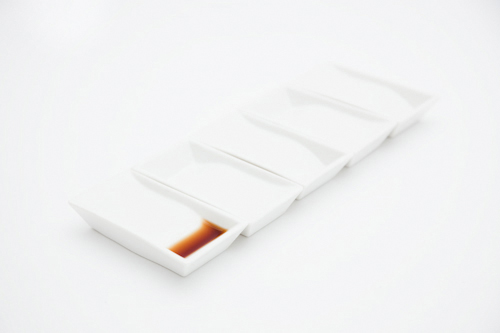
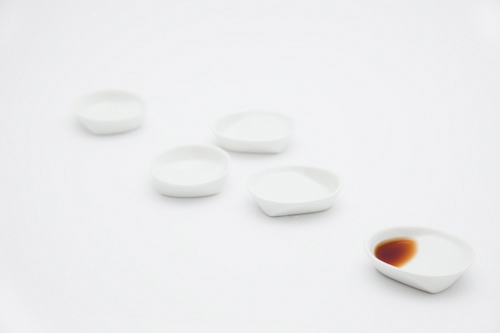
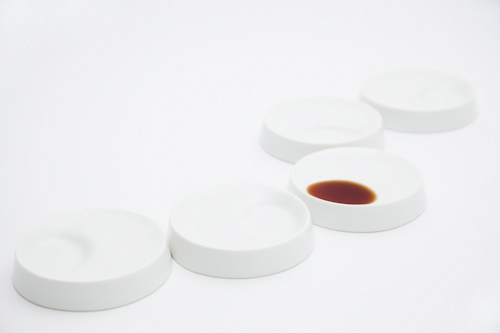

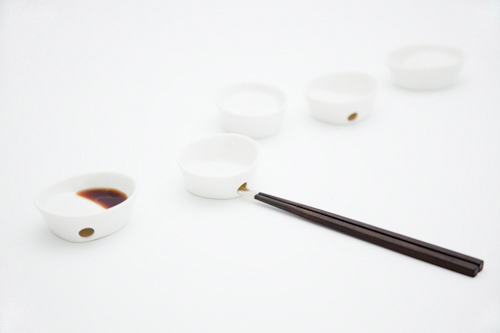
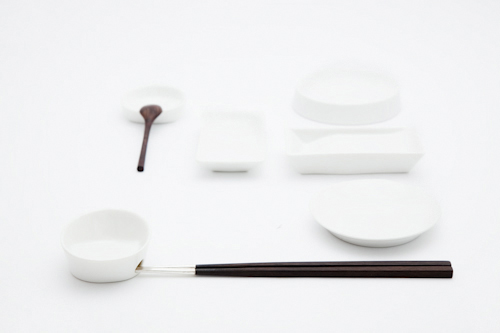
2005 Redesigning of soy sauce plates
本来、日本の醤油というものは、木樽で2年以上天然醗酵をさせたものです。
現在、国内はもとより海外でも一般的に売られている醤油は、大手企業による大量生産の目的で開発された、一時間でケミカル醗酵させたもので、塩分を取りすぎ、体にもプラスが少ない物と言われています。
現在は、これらが安価で手に入るため、本来の醤油が高価なものとなり、一般に知られなくなってきました。そして、丁寧に木樽で製造している会社は、年々減っているのが現状です。
この醤油皿は、それらの貴重な醤油を無駄無く残さず使う用途も含みます。そして、無駄に下水に流し、水を汚さない為にも。
日本の食事は、大豆製品が多く使われます。しかし、日本国内の大豆の自給率は3%で、すべて輸入に頼っている現状なども真剣に考えねばなりません。日本は、ブラジルからの輸入が多く、このブラジルでは、アマゾンの原生林を破壊した畑が作られています。マクロビオティックを含む日本食の浸透は、安易に喜ぶ事はできません。
食べ物のトレサビリティーが、日本でいま欠けています。食事を感謝して食べる事、TVなどに任せて、食卓から会話が消える事などは、とても残念な社会現象です。
この醤油皿のシリーズは、醤油を入れた時にとても美しいグラデーションで深みを表現します。その他、箸置きなども兼ねる物です。液体以外にも、香辛料や、薬味、調理中の味見などから、カラトリー等を置くものとして、使う方のアイディアで様々に機能します。
The Soy Sauce Plate series, Hamabe, Hotori, and Fullike
The soy sauce generally sold these days in Japan and abroad, and mass-produced by major companies is not good for your health, since it contains too much salt and is made in just an hour through a chemically treated fermentation process. While this method of mass-producing soy sauce had been adopted as a matter of course in Japan, originally, authentic makers of the sauce produce it by fermenting it in a wooden barrel for two years.
At present, since soy sauce can be acquired at low prices, the original soy sauce has become relatively costly and even elusive. Additionally, the number of authentic companies manufacturing the sauce with meticulous care using wooden barrels is dwindling every year.
I designed the soy sauce plates for this series with several purposes in mind, but one of the chief ones is to help prevent the wasteful consumption of such pristine-quality soy sauces, and consequently, help prevent the wasteful disposal of the sauce into the drainage, which causes pollution of the water supply.
While the spread of Japanese cuisine, including the macrobiotic diet, may be a positive trend to some, I, for one, cannot be too happy about it. This is because Japanese meals are prepared with a lot of soybean products and to meet this demand, virgin forests in the Amazon are being destroyed to accommodate soybean plantations. Apparently, Japan needs to rely on Brazil for most of its soybean imports, since the self-sufficiency rate of soybean production within Japan stands at 3%. Still, I believe that this is a matter that needs to be taken seriously.
The traceability of food in Japan is currently lacking, while its people are neglecting to express gratitude for their food and are letting the TV replace conversations at the dining table. It is very disappointing to see the occurrences of such societal phenomena.
This series of soy sauce plates express depth with beautiful gradations produced when pouring soy sauce into them. Additionally, they serve as a chopstick rest as well. In fact, the plates could be used in a variety of ways. For instance, in addition to using it for liquids in general, they could be used to set spice containers and cutlery on.
醤油皿というものは、小さな物が多く、はみ出しやすく、こぼれやすい。醤油に一度つけると、置く所も無く、刺身や、にぎり寿司などで付け過ぎた醤油をきる所も無い上に、入れ過ぎて捨てる事も多い。すべてのモデルは、箸置きを兼ねます。小皿などの食器の多い日本の食卓の見直しも考えています。
Redesigning of soy sauce plates
These 3type plates are designed as soy sauce plates. Traditional soy sauce plates are mainly designed so small just to pour soy sauce in, sometimes does not have enough space to put food on. It is great idea soy sauce can be used as a chop sticks pillow(hashi-oki). Also it will be redesigned along to the concept of water's birth.
HAMABE-A
海の浜辺に見立てたモデルです。刺身やお寿司など海の物をお勧めします。
HAMABE-B
同じく、海の浜辺をイメージしたモデルですが、うちでは台所に据え置きで、オタマ置きやスープの味見などにも使えます。
HOTORI-A
湖の畔に見立てています。デザートなどにも最適です。
FULLIKE-A
箸とセットになるものなので、古木が倒れ込んだ様な山奥の古池をイメージに。
箸先が穴にすっぽりと収まりますので、おっちょこちょいで、よくお箸をコロコロと落としてしまう方!最適です。
FULLIKE-B
全てのモデルは、塩/薬味/香辛料などにも使えます。